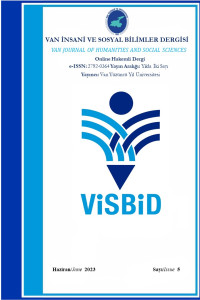Abstract
Doğu Anadolu Bölgesi’nin Yukarı Murat-Van Bölümünde bulunan Bitlis iline bağlı Ahlat ilçesi, tarihsel süreç içinde birçok devlet veya beyliğin idaresi altında kalmış, her devlet veya kültür bu verimli topraklar üzerinde çeşitli izler bırakmıştır. Bu sayede şehir yaklaşık beş bin yıllık geçmişiyle günümüzde adeta bir açık hava müzesi hüviyeti kazanmıştır. Ortaçağın gözde şehirlerinden biri olan Ahlat, dönemin önemli bir bilim-kültür ve ticaret merkezlerindendir.
Ahlat; doğal kaynakları, verimli arazileri ve önemli ticaret yollarının üzerinde bulunuyor olması hasebiyle birçok devletin hakimiyeti altında kalmıştır. Özellikle ortaçağda yoğun bir iskân faaliyeti geçiren bu şehir; dışardan göç alan önemli bir ticaret merkezidir.
XIII. ve XIV. yüzyıllarda Belh ve Buhara ile birlikte “Kubbetü’l-İslam” sıfatını taşıyan Ahlat’ta Ortaçağ boyunca yoğun iskân faaliyetleri hakimdir. Bölgede sırasıyla Emevi, Abbasi, Mervanoğulları, Selçuklular, Ahlatşahlar, Harzemşahlar, Anadolu Selçuklu, İlhanlı, Celayirler, Karakoyunlu, Akkoyunlu, Safevi ve Osmanlı gibi Türk ve İslam medeniyetleri arasında el değiştirmiştir. Ortaçağın büyük merkezlerinden biri olan bölgede çeşitli devirlerden kalan eserler yer almaktadır. Bu kültürel mirasın önde gelen yerlerinden biri olan Selçuklu Meydan Mezarlığı kitabeleriyle Türk-İslam kimliğini yansıtmaktadır. 12.-16. yüzyılları arasında aktif olarak kullanılan mezarlıktaki mezarlar, boyları zaman zaman 4 m. bulan devasa şahide ve sandukalarıyla Anadolu mezar taşları içerisinde emsalsiz bir yere sahiptir. Kitabeler dışında Mezarlıktaki mezar taşlarında yaklaşık 500 örnekte sanatkâr kitabesine yer verilmesi bu mezar taşlarını daha cazip kılmıştır. Anadolu’nun farklı yerlerinde görülmeyen bir uygulama Ahlat’taki mezar taşlarını oldukça önemli kılmıştır. Dönemin mimari yapılarında da çalıştığı anlaşılan bu sanatkârlardan biride araştırmaya konu olan Esed Bin Bergidir. Sanatçının Meydan Mezarlığı’nda tek eseri tespit edilmiştir. Çalışmaların devamında Ahlat Mezarlıklarında başka eserlerinin de bulunması ihtimal dahilindedir.
References
- Ayaz Başak, M. (2008). Gevaş Mezar Taşları, Yüzüncü Yıl Üniversitesi Sosyal Bilimler Enstitüsü Basılmamış Yüksek Lisans Tezi, Van. Karahan, R., Tekin, R., Kulaz, M., Reisoğlu, S., İgit, İ., Oral, M., Alp, A., (2019). Ahlat Selçuklu Meydan Mezarlığı ve Mezar Taşları. Ankara: Dijital Baskı Merkezi. Karahan, R., Kulaz, M. (2019). Ahlat Selçuklu Meydan Mezarlığı 2018 Yılı Kazı Çalışmaları. 41., Ankara: Uluslararası Kazı, Araştırma ve Arkeometri Sempozyumu, c. (4) 17-21Haziran, 31-35. Karahan, R., Reisoğlu, S. (2020). Ahlat Meydan Mezarlığı Kadılar Bölümü Mezar Taşları, İstanbul: Dergah Ofset Kağıt Sanayi ve Ticaret Limited Şirketi. Karamağaralı, B. (1992). Ahlat Mezar Taşları, Ankara: Kültür Bakanlığı Yayınları. Kulaz, M., İgit, İ. (2021). Ahlat Selçuklu Meydan Mezarlığı’nda Tarihin Görgü Tanıkları Ayağa Kalkıyor, Ankara: Azım Matbaacılık, 21-22.
Abstract
Ahlat district of Bitlis province, located in the Upper Murat-Van Section of the Eastern Anatolia Region, has been under the rule of many states or principalities throughout the historical process, and every state or culture has left various traces on these fertile lands. In this way, the city has almost gained the identity of an open-air museum with its history of approximately five thousand years. Ahlat, one of the favorite cities of the Middle Ages, was an important science, culture and trade center of the period.
Wild pear; Due to its natural resources, fertile lands and being on important trade routes, it has been under the domination of many states. This city, which had an intense settlement activity especially in the Middle Ages; It is an important trade center that receives immigrants from abroad.
XIII. and XIV. In Ahlat, which had the title of "Kubbetü'l-Islam" together with Belh and Bukhara in the centuries, intense settlement activities were dominant during the Middle Ages. In the region, it changed hands between Turkish and Islamic civilizations such as the Umayyads, Abbasids, Mervanogullari, Seljuks, Ahlatshahs, Hazermshahs, Anatolian Seljuks, Ilhanli, Celayirli, Karakoyunlu, Akkoyunlu, Safavid and Ottoman. There are artifacts from various periods in the region, which is one of the great centers of the Middle Ages. Seljuk Square Cemetery, one of the leading places of this cultural heritage, reflects the Turkish-Islamic identity with its inscriptions. 12.-16. The tombs in the cemetery, which were actively used between the centuries, are sometimes 4 m in height. It has a unique place among Anatolian tombstones with its huge witness and coffins. In addition to the inscriptions, the presence of the inscription of the craftsman in approximately 500 examples on the tombstones in the cemetery has made these tombstones more attractive. This practice, which is not seen in different parts of Anatolia, has made the tombstones in Ahlat very important. Esed Bin Berg, who is the subject of the research, is one of these artists who seem to have worked on the architectural structures of the period. The only work of the artist has been identified in the Meydan Cemetery. It is possible that other works will be found in the Ahlat Cemeteries in the continuation of the studies.
Keywords
Ahlat Seljuk Square Cemetery Medieval Tombstone Esed Bin Bergi Ahlat, Seljuk Square Cemetery, Medieval, Tombstone, Esed Bin Bergi,
References
- Ayaz Başak, M. (2008). Gevaş Mezar Taşları, Yüzüncü Yıl Üniversitesi Sosyal Bilimler Enstitüsü Basılmamış Yüksek Lisans Tezi, Van. Karahan, R., Tekin, R., Kulaz, M., Reisoğlu, S., İgit, İ., Oral, M., Alp, A., (2019). Ahlat Selçuklu Meydan Mezarlığı ve Mezar Taşları. Ankara: Dijital Baskı Merkezi. Karahan, R., Kulaz, M. (2019). Ahlat Selçuklu Meydan Mezarlığı 2018 Yılı Kazı Çalışmaları. 41., Ankara: Uluslararası Kazı, Araştırma ve Arkeometri Sempozyumu, c. (4) 17-21Haziran, 31-35. Karahan, R., Reisoğlu, S. (2020). Ahlat Meydan Mezarlığı Kadılar Bölümü Mezar Taşları, İstanbul: Dergah Ofset Kağıt Sanayi ve Ticaret Limited Şirketi. Karamağaralı, B. (1992). Ahlat Mezar Taşları, Ankara: Kültür Bakanlığı Yayınları. Kulaz, M., İgit, İ. (2021). Ahlat Selçuklu Meydan Mezarlığı’nda Tarihin Görgü Tanıkları Ayağa Kalkıyor, Ankara: Azım Matbaacılık, 21-22.
Details
| Primary Language | Turkish |
|---|---|
| Journal Section | Research Articles |
| Authors | |
| Early Pub Date | June 22, 2023 |
| Publication Date | June 21, 2023 |
| Submission Date | October 7, 2022 |
| Published in Issue | Year 2023 Issue: 5 |
ViSBiD, MLA ve Crossref tarafından indekslenmektedir. Ayrıca Index Copernicus takip sistemine alınmıştır.


